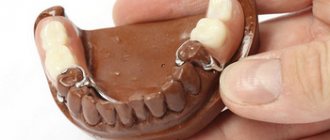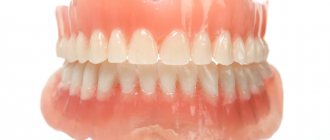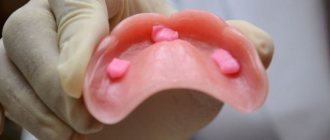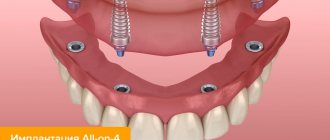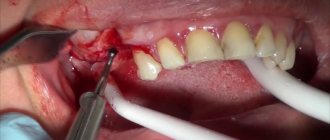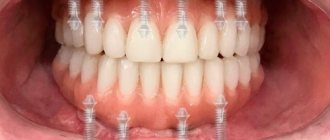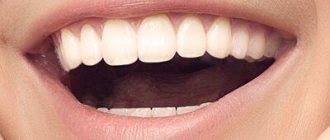27.11.2019
Today, teeth can be restored even if they are completely absent from the oral cavity. At the same time, it is not necessary to implant implants to attach a removable denture. There is a non-traumatic way to regain your dental organs, albeit artificial ones - these are dentures with suction cups. Let's look at their features in this article.
Design of a prosthesis with suction cups and its fixation
In fact, there are no suction cups in removable dentures. A denture with suction cups is made of polymer materials, and the suction effect is created by making it using precise impressions of the jaws.
When making a denture, a dental technician pays great attention to its edges, because they will touch the transition zone between the fixed and moving parts of the mucosal border. The edges should overlap the area where the gum joins the lip or cheek by 1-2 millimeters. This creates a circular valve that prevents the formation of air under the prosthesis. It is for this reason that the denture seems to stick to the gums.
The prosthesis is held in the desired position using suction cups thanks to two of its features:
- Suction, achieved due to the vacuum in the cavity between the prosthesis and the mucosa.
- Adhesiveness is achieved due to the complete compliance of the surface of the structure with the relief of the gums and palate, as well as the presence of a layer of saliva between them.
These structures on the upper jaw hold up much better than on the lower jaw. After all, the upper jaw is characterized by less mobility and a larger area of the hard palate. To fix the product more firmly on the lower jaw, special glue is used.
Price
- Primary appointment (examination, consultation) with a dentist (special offer) 100001
For free
Promotion
- Prosthetics with partial removable lamellar dentures (up to 3 teeth) 153001
9 900 ₽
- Prosthetics with partial removable lamellar dentures 153002
29 000 ₽
- Manufacturing of removable prosthesis Quadrotti 153006
59 000 ₽
- Prosthetics with removable clasp dentures 153007
59 000 ₽
Removable dentures without a palate are compact orthopedic structures designed to restore the integrity of the upper row of teeth. Traditionally, the upper denture is equipped with a palatal plate for vacuum fixation to the hard palate. Adaptation to such products lasts up to 3 weeks. Some patients cannot get used to it and refuse prosthetics, which reduces their quality of life. A removable denture without a palate is much smaller. The patient gets used to it in 7-10 days.
Advantages and disadvantages
Let's consider the main advantages of suction cup prostheses:
- Aesthetic component - all the curves of the teeth and gums are repeated, the color matches the natural one.
- Comfortable use thanks to the elasticity of the material.
- Affordable price.
- Quick adaptation without much discomfort.
- Tight fit to the gums.
- The safety of the prosthesis on suction cups, which does not lead to injury to the gums, tongue and cheeks.
- No chafing or swelling.
- High wear resistance.
- Functionality regarding chewing and speaking. The products are effective even when chewing hard food (meat).
- They do not require grinding of teeth before prosthetics.
- They can be retained in the oral cavity even with complete edentia.
- There is no displacement of the prosthesis when eating.
- There are no absolute contraindications for use.
- Can be used at any age.
The products also have disadvantages. They are as follows:
- Not very reliable fixation on the lower jaw. In this case, you need to use special glue.
- Some substances contained in the prosthesis may cause an allergic reaction.
- For care, be sure to purchase a special cleaning brush.
- Possibility of formation of a gag reflex during the first period of wearing.
- You should not chew nuts, crackers, etc. with your teeth. Viscous foods that can stick are also prohibited.
- Short service life. It is recommended to change such prostheses every 4 years.
- The load when using a prosthesis is distributed unevenly, which can cause bone tissue atrophy.
Indications and contraindications
Let's consider the main advantages of suction cup prostheses:
- Aesthetic component - all the curves of the teeth and gums are repeated, the color matches the natural one.
- Comfortable use thanks to the elasticity of the material.
- Affordable price.
- Quick adaptation without much discomfort.
- Tight fit to the gums.
- The safety of the prosthesis on suction cups, which does not lead to injury to the gums, tongue and cheeks.
- No chafing or swelling.
- High wear resistance.
- Functionality regarding chewing and speaking. The products are effective even when chewing hard food (meat).
- They do not require grinding of teeth before prosthetics.
- They can be retained in the oral cavity even with complete edentia.
- There is no displacement of the prosthesis when eating.
- There are no absolute contraindications for use.
- Can be used at any age.
The products also have disadvantages. They are as follows:
- Not very reliable fixation on the lower jaw. In this case, you need to use special glue.
- Some substances contained in the prosthesis may cause an allergic reaction.
- For care, be sure to purchase a special cleaning brush.
- Possibility of formation of a gag reflex during the first period of wearing.
- You should not chew nuts, crackers, etc. with your teeth. Viscous foods that can stick are also prohibited.
- Short service life. It is recommended to change such prostheses every 4 years.
- The load when using a prosthesis is distributed unevenly, which can cause bone tissue atrophy.
Types of products
With respect to the material being manufactured, suction cup dentures are divided into:
- Acrylic ones appeared earlier than other types of suction cup prostheses. They completely replicate the external features of living teeth and gums. Manufactured by injection molding. The inner side of the denture is equipped with a silicone insert, which distributes the load when chewing. Dentures with suction cups last a long time and are inexpensive. The main disadvantages are the presence of a toxic substance in the composition that can cause allergic reactions, the inability to resist mechanical damage and the porosity of the material, which promotes the development of microorganisms on the product.
- Nylon is hygroscopic and therefore resists the development of microorganisms. Their advantages are also elasticity, minimal trauma to the mucous membrane, high resemblance to living gums and teeth, resistance to staining, high suction ability, long service life, the ability to withstand significant loads when chewing, the absence of allergens and the ability to install them on weak gums. The negative aspects include the need to use a special solution and a special brush for cleaning, as well as the lack of possibility of restoration (if it breaks, the design is completely changed).
- Polyurethane dentures are made from flexible plastic. They are the most popular today in comparison with other types of products. Suction cup dentures are flexible, elastic, have excellent suction, strength, and durability. They do not absorb moisture, do not cause allergies, do not deform from heavy loads and high temperatures, last a long time and are inexpensive. If the patient has several of his own teeth, the denture is made so that the palate is open, without blocking the taste buds.
- Polypropylene prostheses are the oldest option, used back in the 70s of the 19th century. They are durable and elastic. This material is characterized by high plasticity, which contributes to a good fit to the palate and the absence of displacement during conversation. During manufacturing, a frame is made of polypropylene, and artificial dental organs are attached to it. Polypropylene is practically transparent, merging with the mucous membrane after installation.
Polypropylene - a classic material
Polypropylene is the classic option. The first removable vacuum dentures were made from it. And today it is used because the products have valuable characteristics. Prostheses are quickly manufactured. This material is lightweight and durable. It is characterized by transparency. During manufacturing, they do not try to replicate the color of the gums, since the natural color is not hidden. This makes the technology cheaper. At the same time, the prostheses remain invisible and are attractive from an aesthetic point of view. True, if a person is used to smiling often and the shape of the lips and jaw is such that a large area of the gums is visible, another option should be preferred. The individual characteristics of the human body and the characteristics of the situation play a decisive role in deciding which prostheses are best to choose.
Installation
In order to make a removable denture with suction cups, an impression of the patient's gums is taken. Further along the sky, a structure will be made from the material chosen by the patient.
Then the finished prosthesis is inserted into the oral cavity and checked how tightly it fits.
The structure is secured through a suction effect. Special means for fixing dentures, such as glue, which can be purchased at a pharmacy, can also be used. They are especially needed for fixing the prosthesis with suction cups on the lower jaw.
Acrylic vacuum dentures
Acrylic plastic is the traditional material for their manufacture. This material allows you to create a less accurate imitation. But the aesthetic value is not lost. They look great. You have to look closely to notice the prosthesis. The right shade guarantees success.
The downside is that some people are allergic to this material. Her symptoms will not go away just by taking appropriate medications. It is necessary to exclude contact with the allergen. A silicone layer is used, which reduces the risk of allergies and improves the degree of fixation. The potential threat that exists due to the rather high density and hardness of the material is eliminated.
Duration of use
Thanks to the latest developments and methods of processing plastics, removable dentures are now produced with a longer service life than before.
Note: Products with suction cups are flexible, soft and lightweight, and due to their strength, they are resistant to breakage.
For long life, you need to visit a doctor twice a year. Then the prosthesis will last on average 5 - 7 years. Also, while wearing the structure, its correction may be required.
Features of care
Caring for dentures determines how long they will serve the patient.
Let's consider the basic rules for caring for the structure:
- After each meal, the structure must be removed and washed under running water.
- Before inserting the product into the oral cavity, it should also be cleaned.
- The structure needs to be cleaned once or twice a day. To do this, use a soft brush and low-abrasive paste.
- At night, the prosthesis with suction cups does not need to be removed.
- You can use dental floss for cleaning.
- About once a week, the denture should be immersed in a special liquid for disinfection.
- Visit your doctor regularly at least once a year.
If the material loses its color, it can be bleached. Moreover, it is best to do this in dentistry, since independent manipulation of the product can harm it. But using tablets (for example Corega or Lakalut) at home is quite possible. They have a disinfecting effect and remove plaque.
What problems can be avoided?
Let's consider what problems can be solved when using prosthetics with a removable orthopedic design:
- the aesthetics of the smile is restored,
- the gums in the area of the row defect (missing tooth) are protected from injury by hard pieces of food,
- bite relationships and occlusion are preserved: therefore, the antagonist (opposite from above or below) does not move down or up,
- neighboring teeth are not so overloaded during chewing,
- The teeth adjacent to the defect do not move: if you leave a “gap” in the row and do not perform prosthetics, then the “neighbors” on the right and left will gradually shift towards it. Thus, in the future it will be difficult to install a prosthesis or even have to wear a brace system.
Repair
Suction cup dentures can become damaged or break. Failure can be caused by severe mechanical stress, improper use, or a manufacturing defect that was not noticed in time.
It is often much more profitable to repair a broken structure than to make a new one. Moreover, with long-term use, when the gums have already become accustomed to the product, it should not be changed in case of minor damage.
Category Dentures Published by Mister stomatolog
